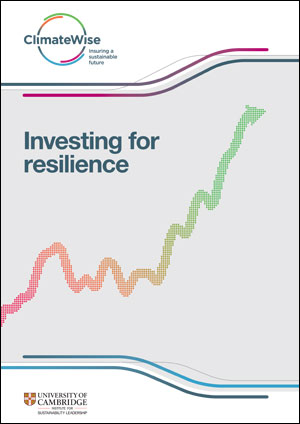December 2016 – Investing for Resilience explores how the insurance industry can contribute to redirecting substantial flows of capital into resilience enhancing investments. This includes helping in the development of a resilience rating system.
About the report
Traditional response to rising levels of risk – to re-price, withdraw or transfer exposure to others – will always remain a central feature of how insurance manages its risk pools. However, society will struggle to reduce the climate risk protection gap – the growing divide between total economic and insured losses – if the insurance industry’s response to climate change is limited to avoiding, rather than managing the risk. Managing societal resilience to climate change will therefore become more important as exposure intensifies.
In response, ClimateWise’s Societal Resilience Programme, of which this study is part, brings ClimateWise members together with a range of stakeholders to identify actionable solutions for how the insurance industry can support society’s transition to a zero carbon, climate-resilient economy. It explores this via the industry’s investment activities.
Investing for Resilience explores the relationship between the insurance industry, its investment activities and its potential support for resilience-enhancing investments. Consequently, the report provides a foundation for further research and discussion across this crucial area.
Findings
It finds that insurers are not the natural investors in resilience many external commentators believe them to be. While there is a strong customer-oriented motive to improve resilience to climate risks, through good risk management, there is not yet a direct relationship between direct investments in resilience enhancing investments (such as infrastructure) and increased underwriting profits.
However, the report identifies numerous ways that insurers can support investments in climate resilience more broadly across the financial markets. The report also highlights how there is currently no effective method of measuring resilience of investments, of property, of municipalities, of corporates etc. The development of a widely applicable resilience rating system would enable the consideration of resilience across multiple areas of decision-making, including asset management, policymaking, and risk management.
The insurance industry, with its array of stakeholders and involvement in so many spheres of economic activity, is well placed to help lead and co-ordinate increased investments in resilience. This could lead to many new commercial opportunities for the industry.
Citing this report
Please refer to this report as University of Cambridge Institute for Sustainability Leadership (CISL). (2016, December). Investing for resilience. Cambridge, UK: Cambridge Institute for Sustainability Leadership.




